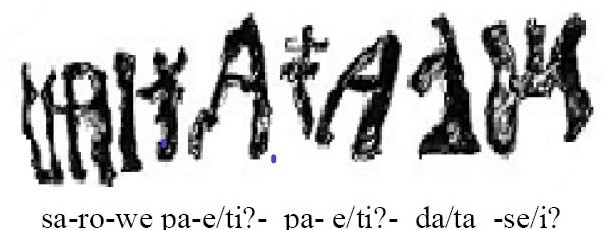Τhe Tiles of Ashkelon
Τhe inscription of Ashkelon. The Philistine power doctrine.
They were found during excavations in the Ancient Ashkelon settlement, in Israel. They date back to 1500 B.C..

The inscription found during the excavations of the Christian Basilica of Ashkelon, in Israel.
The development and projection of the phonetic values, from left to right, as the researcher Minas Tsikritzis identified them from the ceramic discovery.
In the text we can find sayings about power .
The text is a document of the behaviour of those in power towards the citizens.
We studied the phonetic values in the actual text. We understood it, we read and rendered it into Modern Greek, but we also approached it philosophically.
SA-RO-WE-PA-TI-PA-TI-TA-SE
Figuration of the phonetic values of the text.
In our own view, the phonetic values are formed as follows, through the reading from left to right:
SARO WE PATI PATI TASE
The language of the text is Greek, Archaic, typical of any Minoan text of Linear B Script. The grammatical structure of the text is mixed.
One can identify Pontic words, as well as Classical Greek Language.
The utterance of the words and of the verbal types, follows the grammatical rules of the Pontic Dialect, as well as those of the Classical Greek Language.
Rendition of the text:
Σαρ βε πατεί. Πάτει και τάσσε.
The Τext in Modern Greek:
Stomp on the power, giving orders.
(Το πέπλο της εξουσίας βρε πατεί. Πάτα δίνοντας διαταγές).
A Second Approach, from right to left.
The phonetic values through reading from right to left, are the following:
SE-TA-TI-PA-TI-PA-WE-RO-SA
Figuration of the phonetic values of the text.
In our own view, the phonetic values are formed as follows, through the reading from right to left:
SE TATI PATI PA WERO SA
Rendition of the text:
Σε τάτι πατεί πα βέρως σα.
The Τext in Modern Greek:
He certainly obeys and submits to your will.
(Για εσένα υποτάσσει και καταπιέζει καθαρώς στα δικά σου θελήματα).
A Philosophical Approach:
Ashkelon is a seaside town in Philistine, Gaza. It is situated in the southern part of Tel Aviv, in Israel.
Red ceramic inscriptions were found during the excavations of the Christian Basilica in 1969, which date back to the 15th century B.C..
Only a part of the text has been saved, so its meaning is not complete. However, in the saved extract, the reader can pinpoint the power doctrine.
The meaning is almost the same, no matter the reading direction.
The text proves that Greeks either may have lived in the land of Philistine, or left their commercial footprint, as pottery traders. There is however a possibility that people in Philistine have Greek roots.
